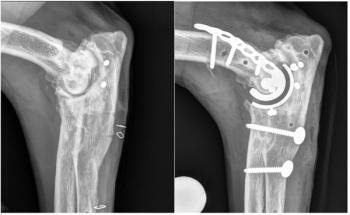
- August 2017
- Volume 2
- Issue 4
AAHA 2017: Analysis of Pleural, Peritoneal Fluid
Proper analysis of pleural or peritoneal fluid can go a long way toward verifying a diagnosis and directing treatment recommendations. Sample preparation and handling can have a significant effect on the accuracy of test results.
Proper analysis of pleural or peritoneal fluid can go a long way toward verifying a diagnosis and directing treatment recommendations. Sample preparation and handling can have a significant effect on the accuracy of test results, according to Mike Scott, DVM, PhD, DACVP (Clinical Pathology), associate professor in the Department of Pathobiology and Diagnostic Investigation at Michigan State University College of Veterinary Medicine.
Dr. Scott talked about the importance of sample handling, transportation, and accurate fluid analysis at the American Animal Hospital Association (AAHA) Annual Conference in Nashville, Tennessee.
When a fluid sample is obtained from a patient and submitted for laboratory analysis, natural processes alter the character of the fluid’s components, making it difficult to ensure that the sample harvested from the patient has the same characteristics as the sample that arrives at the laboratory. For example, Dr. Scott noted that cell deterioration begins as soon as the sample is collected.
Phagocytosis of contaminant bacteria can occur within minutes, and phagocytosis of erythrocytes can occur within hours. Microbes can also proliferate in the fluid before it can be analyzed at the diagnostic laboratory.
Sample Handling
Some alterations in sample character are difficult to avoid, but careful handling can minimize the impact of these processes on diagnostic accuracy. Dr. Scott commented that the most common errors he sees involve inappropriate sample preparation and shipment. For example, failure to keep a sample at the proper temperature during shipment can affect sample quality.
“Fluids should be mailed to arrive overnight, and the package should be insulated and contain ice packs to limit cell deterioration. The sample itself should also be insulated from ice packs so it won’t freeze,” Dr. Scott said. He also recommends using aseptic technique to collect the fluid and, once the sample is obtained, submitting some of the fluid in an EDTA tube to hinder clotting of bloody or proteinaceous samples. Another aliquot can be collected into a regular tube with no clot activator or gel.
Slide Preparation and Submission
To optimize testing accuracy, Dr. Scott advises providing prepared slides with the fluid specimens that are submitted in the tubes. “We recommend sending cytologic preparations made from the fresh fluid so that cell appearance, as it was prior to any in vitro change, can be assessed,” he noted. At least 2 unstained smears should be submitted with each stained smear, and rigid slide holders should be used for shipment.
Making the correct slides for cytologic analysis depends on the nature of the fluid, Dr. Scott cautioned. Cloudy fluid can be used to make direct smears using the “wedge” technique many veterinarians and technicians employ to make blood smears.
However, if the fluid is clear, it is helpful to create a concentrated sample for slide preparation. To do this, place the fluid sample in a tube and spin it in a centrifuge (as if preparing a urine sample for analysis of sediment). Then, remove the supernatant, resuspend the sediment in the remaining fluid, and use the concentrated material at the bottom of the tube to make the slide.
Dr. Scott also described an alternate technique for slide preparation of concentrated material. “Another option is to make flowback (ie, line, stop-flow) preparations,” he said. “The procedure to make these starts as that for a direct smear, but when the spreader slide reaches about two-thirds of the way across the slide, stop the spreading and lift the spreader slide up to yield a straight edge rather than a feathered end to the smear. Then tip the slide vertically so that the fluid at the end of the smear flows back down toward the base. This concentrates cells and spreads them out.”
If a concentrated sample is created for submission of slides, that should be noted on the laboratory submission form. Otherwise, the cell smear findings may be misinterpreted by laboratory analysts.
Sample Processing
Minor sample processing errors can affect the accuracy of test results. “The impact may be minimal or substantial, an example of the latter being when cell deterioration interferes with recognition of atypical cell populations and prevents a diagnosis of neoplasia that should have been made,” Dr. Scott said. Although preparation and submission errors are common, it doesn’t necessarily mean the sample shouldn’t be used, as important information can still be obtained. However, it is worth the extra effort to follow best-practice recommendations.
Another problem area of the fluid analysis process relates to the terms used to classify and communicate about fluids. Dr. Scott cautioned that fluids are not classified or evaluated consistently in veterinary medicine. “People have often classified effusions as transudates or exudates based primarily on numeric values for protein and cell concentrations, and the cutoffs have varied. Samples in the numeric gray zones have often been called modified transudates.” However, he noted, “Exudates can have low or high protein or cell concentrations under various circumstances, effusions can have high cell concentrations but not be exudates, transudates can have low or moderate protein concentrations depending on their source, and many fluids classified as modified transudates are not transudates that became modified as the name implies. So, protein and cell concentrations do not necessarily reflect the pathogenesis of the fluid accumulation.”
Dr. Scott uses a classification approach that aligns the composition of effusions with their pathogenesis, as much as possible. This requires attention to microscopic findings, other patient findings, and knowledge of how effusions form. For example, although exudates typically have increased protein concentrations and higher nucleated cell concentrations (commonly predominated by neutrophils), if a patient is hypoproteinemic, it could have an exudate without a high protein concentration. Similarly, a septic exudate from a neutropenic patient may have lower nucleated cell and neutrophil concentrations than anticipated, but phagocytized bacteria would still indicate the presence of exudation and, therefore, inflammation. And high fluid cellularity predominated by atypical lymphocytes would reflect a neoplastic (lymphomatous) effusion, not an exudate.
But not all effusions have a clear pathogenesis. A peritoneal effusion with a low cell concentration (mixed macrophages, lymphocytes, and neutrophils) and a moderate protein concentration could be a proteinaceous exudate or a protein-rich transudate, so Dr. Scott would classify it nonspecifically as a proteinaceous effusion. If the patient was known to be in congestive heart failure, the findings would fit a protein-rich transudate caused by protein-rich fluid emanating from the liver. Dr. Scott advised consideration of these factors when classifying and interpreting fluid analysis findings.
Conclusion
Fluid analysis, including cytology, can be an invaluable tool. As with any diagnostic test, however, sample collection, processing, handling, and interpretation all play roles in the ultimate value of the result. Clinicians can improve the value of these tests by taking a few precautions during sample preparation and handling and interpreting the results in light of the patient’s condition. These minor changes can ultimately result in improved diagnostic accuracy and patient outcomes.
Dr. Todd-Jenkins received her VMD degree from the University of Pennsylvania School of Veterinary Medicine. She is a medical writer and has remained in clinical practice for over 20 years. She is a member of the American Medical Writers Association and One Health Initiative.
Articles in this issue
over 6 years ago
Repair Surgery Among Latest Treatments for Mitral Valve Diseaseabout 8 years ago
ACVIM 2017: Chemotherapy-Induced Vomiting and Inappetenceabout 8 years ago
Keeping Up with Your Educationabout 8 years ago
CVC Virginia Beach 2017: Fear-Based Aggression in Dogsabout 8 years ago
WVC 2017: Pain Control for the Aging Horseabout 8 years ago
Product Spotlight (August 2017)about 8 years ago
WVC 2017: Managing Cats With Upper Respiratory Infectionabout 8 years ago
AAHA 2017: Does Your Practice's Biosecurity Protocol Need a Tune-Up?about 8 years ago
Can Sleep Improve Memory in Dogs?about 8 years ago
Eliminating Canine Rabies From the Western HemisphereNewsletter
From exam room tips to practice management insights, get trusted veterinary news delivered straight to your inbox—subscribe to dvm360.






